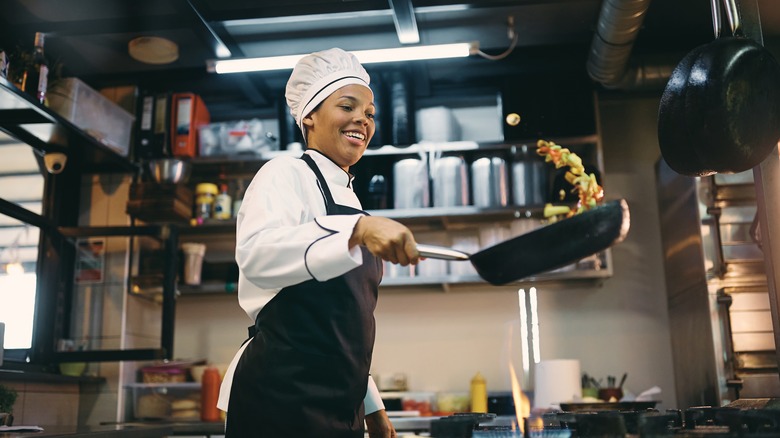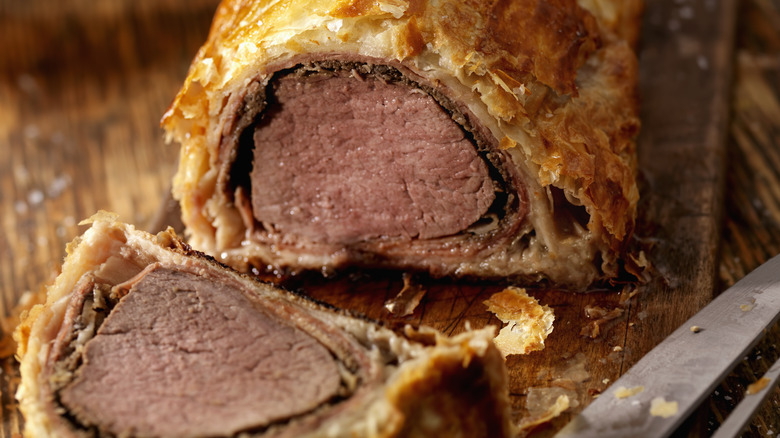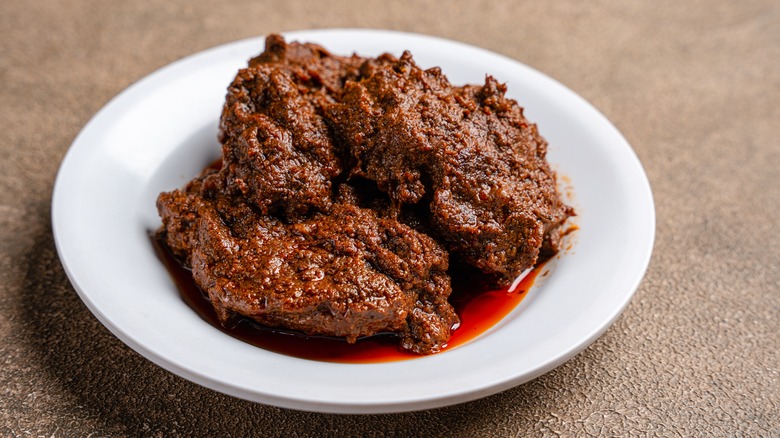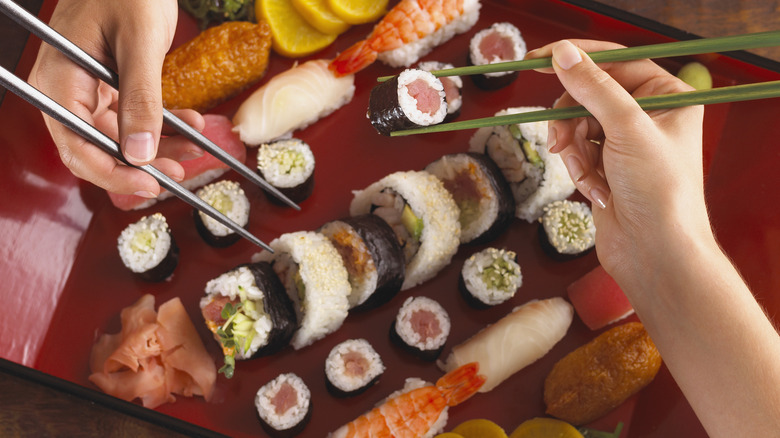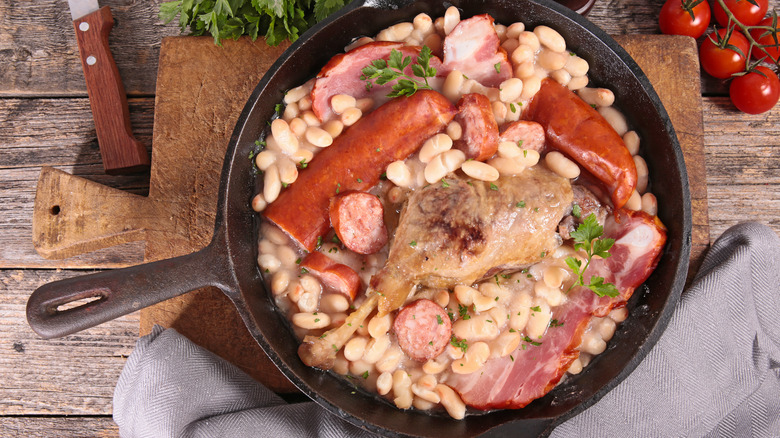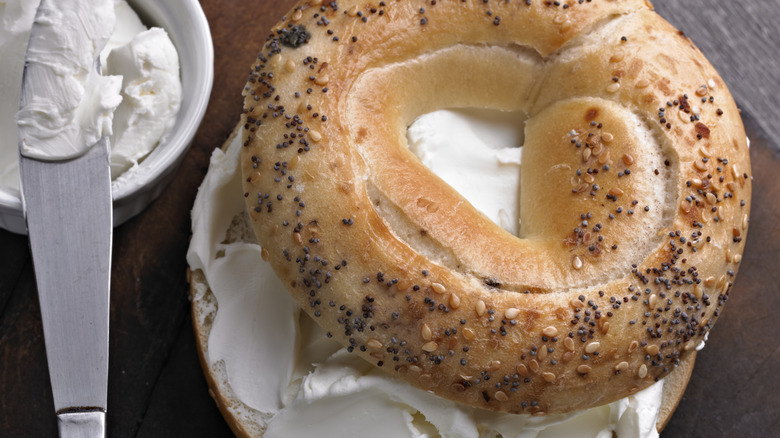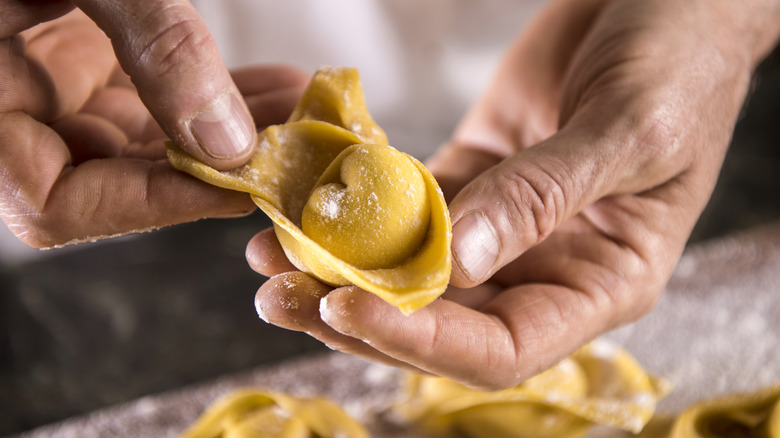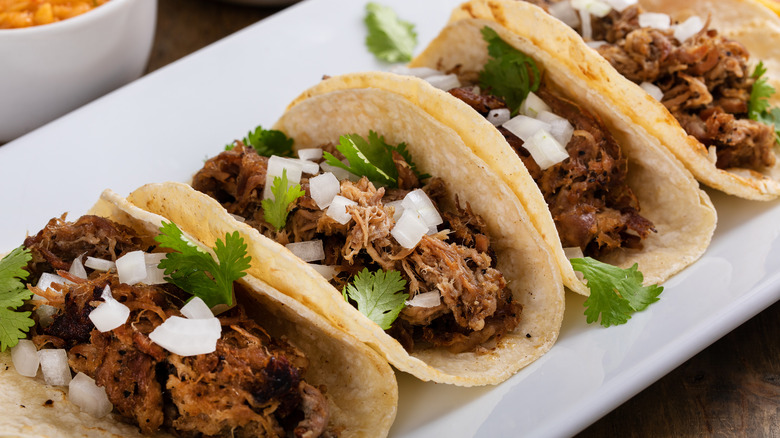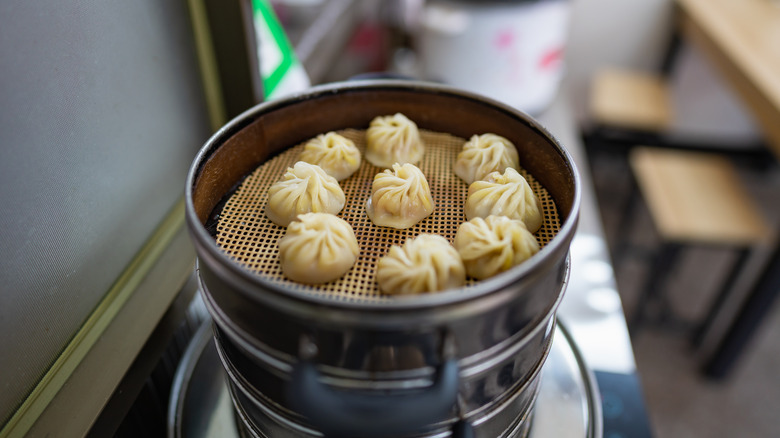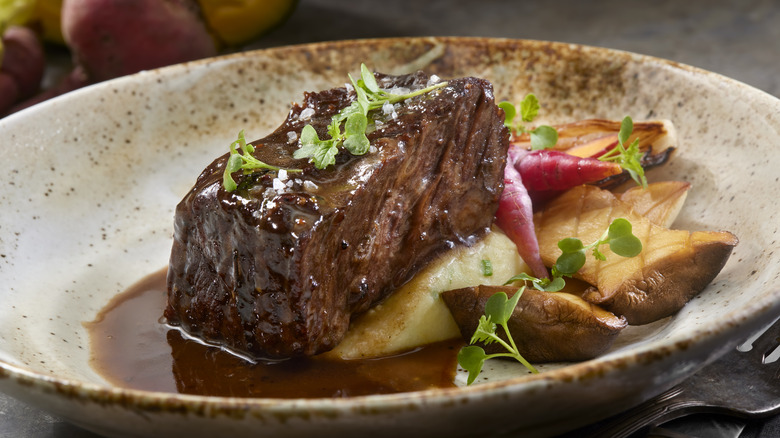14 Foods You Should Order Instead Of Making Yourself
There are few things better than a good meal out at a restaurant. And the act of sampling great food in an attractive setting can improve our well-being way more than we might think. Eating out is as much a social pleasure as it is a culinary one. According to a study conducted by the University of Oxford, the frequency that we dine out with friends appears to correlate with how happy and fulfilled we are in our day-to-day lives. This doesn't just happen if we're heading out with buddies, either. Dining out alone is a form of communal eating in itself, says research published by the Journal of Consumer Culture, and therefore may provide some of the same benefits.
But let's be real: While we love the good company and atmosphere that you get when eating out, what we're really crazy about is being able to sample delicious, diverse foods. Dining in a restaurant gives you the perfect opportunity to order dishes that you've never tried to make at home and have them prepared by expert chefs. And when you're dining out, you want to make sure you're getting the best bang for your buck, instead of feeling like you could have made it yourself. That's why we put together a list of some of the most tricky and time-consuming dishes that you should always order at a restaurant.
1. Beef Wellington
Of all the foods you can order in a restaurant, Beef Wellington might be the one that saves you the most time and effort. This beef dish is notoriously difficult to nail. Allegedly created in celebration of the first Duke of Wellington and his victory at the Battle of Waterloo, this regal meal is made up of a beef tenderloin coated in pâté and duxelles (a mixture of mushrooms, onions, and herbs), which is then fully wrapped in flaky puff pastry.
The combination of textures and deep savory flavors makes this a dish to savor, but it's every chef's nightmare. The tenderloin needs to be first seared to perfection to generate a brown crust on all sides while ensuring that the inside remains rare. The duxelles has to be made separately, which adds extra time and effort, not least because all the ingredients have to be chopped incredibly finely. Constructing the dish can take a huge amount of time, and while you can save time by buying store-bought puff pastry, you still have to cook it just right, ensuring that the bottom doesn't get soggy. All in all, the dish can take hours from start to finish, requires a large amount of skill, and is incredibly expensive if you're buying all the ingredients and making the dish from scratch. We'd prefer to order it.
2. Smoked and cured salmon
There's a very good reason why smoked and cured salmon is easier to buy ready-made in the store or off a menu: They take a long time to make. There may be a difference between gravlax and smoked salmon in terms of flavor, but both can take several days to prepare due to the curing process. These fish dishes are both cured in a salt mixture, covering the salmon fillets in sea salt and any seasonings that the chef chooses. Juniper, fennel, dill, and horseradish are all common additions.
The curing process usually takes a few days, with the salt gently pulling the water out of the fish. This not only preserves the meat somewhat but also softens it and enhances its flavor. Once it's fully cured, gravlax is pretty much ready to go. Smoked salmon, however, is even more labor-intensive. It then has to be smoked over the preferred wood of the chef, with different types of wood imparting different flavors and scents. Once all this is done, the salmon is sliced and prepared for serving. These individual steps are crucial to giving the salmon such a complex and exciting flavor, but they also require specific knowledge of curing and smoking, specialist equipment, and a lot of time.
3. Beef rendang
Beef rendang was ranked as the most delicious dish in the world by CNN, and as such it's a must-order when you see it on a menu. But asking for it in a restaurant will not only let you try this dish at its best, but it'll also save you hours of cooking time. Beef rendang is not just time-expensive, but labor-intensive too. You start by making a spice paste of garlic, ginger, chili, galangal, and shallots, and cooking it alongside whole spices to make a scented oil. After that, beef chuck is added alongside coconut milk and lemongrass.
The whole mixture then has to cook — for a very long time. The slow simmer that the beef undergoes makes it incredibly tender, with the spices intensifying in flavor. This also requires a pretty constant stirring motion, as the milk reduces, with more stirring required as time goes on. Additionally, an extra step is required to give it maximum flavor, which is toasting some shredded coconut, requiring yet another pan and more hands-on time. In total, beef rendang can take 3 hours or more until fully cooked. By ordering it in a restaurant, you save on that time and are treated to the right balance of spices.
4. Croissants
Being a pâtissier requires specialist skills and training, with Le Cordon Bleu training taking nine months, in which you work solely on the art of creating pastry. But with all that time and learning comes the ability to create croissants and pain au chocolat that the average person can only dream of making. Croissants are especially hard to master because of the amount of lamination they require. Laminating the dough essentially involves rolling it out until it's very thin and creating multiple layers, with butter being layered in between them. By doing this, the croissant develops dozens of thin layers that become flaky when baked.
All of this lamination takes a lot of time and careful attention, and in commercial or restaurant settings, it's little wonder that this is done via machine. Doing it at home may take you forever, and it'll be very fiddly to do. And that's all after you make the dough in the first place, which has to be created at just the right temperature and rested properly. If you're really keen on making croissants at home, try starting with some homemade crescent rolls, with pastry courtesy of Pillsbury. From there, you can work your way up to your own pâtissier-level croissants.
5. Eggs Benedict
This all-time classic breakfast dish can be surprisingly complicated for something that looks so simple. The issue lies not so much in how long it takes as in the individual steps you have to take to get there. Arguably the most time-consuming part is making the Hollandaise sauce, which requires a certain level of confidence in working with egg yolks. The thick sauce is created by the emulsifying power of the yolks, which are cooked with butter, heavy cream, and an acidic element — and you have to take it off the hob at just the right time so the eggs don't cook.
Poaching the eggs can also be tricky, and again requires your timing to be precise so that you don't over- or under-cook them. If you're serving Eggs Benedict with additional components, like bacon, avocado, or grilled asparagus, these can also take time to prepare. And it can also be challenging to keep everything at just the right temperature until it's ready to serve. If you're determined to make Eggs Benedict at home but the fresh Hollandaise sauce sounds daunting, you can pick up some pretty good store-bought Hollandaise sauces.
6. Sushi
Anyone who's ever tried to make sushi at home will quickly realize why it's best left to the pros. Sushi tastes better at a restaurant simply because the people who are making it know exactly what they're doing. To be an itamae, or a top sushi chef, it can take five to 10 years of on-the-job training, in which the chefs work their way up from rice preparation, to learning to cut vegetables and garnishes, all the way to handling the fish itself. In this rigorous training, chefs become incredibly in tune with the demands of different types of protein and rice to create the most well-balanced sushi possible.
But it's not just the amount of skill that goes into making sushi that makes it better to order at a restaurant; it's also the amount of time. Making sushi requires you first to prepare, cook, and then prepare the rice once more before letting it cool fully. Your fillings and toppings then have to be prepared separately. Once everything is ready to go, the shaping process takes time, and this can be a lengthy process if you're making nigiri, as every piece has to be made separately. If you don't regularly make sushi, doing so at home can also require purchasing specialist equipment like a bamboo rolling mat, and ingredients like nori and wasabi — and the prices can add up.
7. Cassoulet
Upon first inspection, a cassoulet might look like a simple stew that anyone could make. And while many chefs can rustle it up at home, a true cassoulet can take several days of work to reach its true potential. Cassoulet is a meat and bean stew, with vegetarian cassoulets opting for more beans and flavoring the broth with herbs and garlic. The reason why the meat version takes so long is that each piece of meat (which can include mutton, sausage, duck, and goose) is cooked separately, being browned individually in goose fat to achieve maximum flavor.
The beans also take a large amount of preparation, with cassoulet traditionally made from dried beans. As these legumes need soaking and cooking before they can go into the stew, there's a large amount of work to be done before you even start making the dish proper. This preparation needs to be performed for both the meat and vegetarian version of this dish. Finally, a cassoulet finishes off in the oven, being baked low and slow with a bread crumb topping until piping hot and browned.
If you order a cassoulet in a restaurant, you may well benefit from "mise en place," a process by which chefs prepare their ingredients well in advance so they can create time-consuming dishes to order. At home, though, you may not have this benefit.
8. Bagels
Ever wondered how a bagel gets its uniquely chewy-crunchy texture? It's the result of a lot of time and work. Before bagels are cooked, they have to be proofed once they've been rolled into shape. This proofing process gives the yeast time to activate, which lets them rise and gives them their plump appearance, and they're then refrigerated — for up to a day at a time in some cases.
Then, they undergo an additional step that most other breads don't: They're boiled. By being dunked in hot water, the starch on the surface of the dough starts to gelatinize. It's this step (which is also done when making pretzels) that gives the bagels their uniquely shiny surface and thick, chewy crust.
From there, bagels are topped, and then baked. From start to finish, the process can take several days. While bagels can theoretically be made by anyone, heading to a restaurant or store that makes them will allow you to have the best product. Simultaneously, you'll also be able to buy into the bagel's rich cultural history and sample an authentically-made Jewish-American staple at a relatively low cost.
9. Tortellini
Most of us have picked up a bag of ready-made tortellini from the store at some point. But if you've ever tried to make it fresh at home, you'll quickly realize why store-bought is easier — and why when you order it in a restaurant, you're paying for something that takes the chef a while. Tortellini, like other stuffed pasta and dumplings, is a multi-stage process involving the dough, the filling, and the shaping. It all starts with the dough, which needs to be thin enough to be semi-transparent. In restaurants, they'll use a machine to get it as thin as possible, but if you're making it at home, you might have to roll it by hand, taking a lot of time and arm muscle and potentially producing an inconsistent result.
After the pasta is cut out, the dough needs to be shaped around the filling, a fiddly process that amateurs can struggle with. Air pockets can easily work their way into the dough here, making the pasta hard to cook properly. This is all after you've made the filling itself, which can be pricey if you're going for high-end ingredients like good ricotta, prosciutto, and Parmigiano. Thankfully, once all these stages are done, tortellini cooks in just a few minutes — but the journey there can take a while.
10. Carnitas
Carnitas (which translates to little meats) is a must-try Mexican dish originating from the state of Michoacán. Frequently compared to pulled pork, carnitas consist of pieces of pork butt that have been simmered until tender. But while carnitas may be refreshingly simple to make, requiring little more than meat, liquid, some flavorings, and time, it's the last of these which will make you want to order it in a restaurant.
Carnitas can take several hours to cook, with the meat requiring a low and slow simmering process. When you cook meat at a low, consistent temperature, the formerly-tough fat and connective tissue in it breaks down. It also helps to keep the meat moist. A tenderizing element, like orange juice, is frequently added to carnitas to help the meat break down even further. There's also an additional step required in some cases, which involves pan-frying the tender meat to give it a crispy seared outside. Some restaurants may also make their own tortillas, which adds to the finished meal's deliciousness — and which, if making them at home, can take you significantly more time.
11. Baked Alaska
There's a reason why we consider Baked Alaska to be an order-only dish: It's not for the faint of heart. This dessert is a logic-defying marvel. Ostensibly created in honor of the Alaska Purchase in 1867 by New York-based French chef Charles Ranhofer, Baked Alaska combines the coldness of ice cream with the heat of literal fire. A sponge cake is topped with ice cream before a meringue coating is layered all over it. The whole thing is then, as you might expect, baked in the oven, with a blow torch used to caramelize the coating at the end for good measure.
The reason why Baked Alaska doesn't melt is down to a wonder of science, with the egg white meringue acting as an insulator for the ice cream, keeping it cold. The sponge helps too. "Theoretically, the cake base insulates the ice cream from the hot pan," Sidney Perkowitz, author of "Universal Foam: From Cappuccino to the Cosmos" told Popular Science. But one false move, or a gap in your sponge or meringue, and your Baked Alaska will turn into a pile of melted ice cream in your oven. It's also worth remembering that this whole dessert takes a while to construct, especially if you're making your own sponge. And if you're freezing your Baked Alaska solid before baking it, it needs a good few hours in the fridge. Let the restaurant do the hard work.
12. Soup dumplings (xiaolongbao)
Anyone who's tried soup dumplings, or xiaolongbao, will know how special they are. These unique dumplings were created in the 19th century when restaurant owner Huang Mingxian decided that he wanted to give his diners an exciting new culinary experience. He certainly achieved that with the invention of xiaolongbao. When cooked, they're full of a flavorful, rich soup that makes them completely unique.
However, they're also one of the hardest dumplings out there to make, as well as one of the lengthiest. Xiaolongbao aren't made by spooning liquid into the dough. Instead, the soup is made from melted aspic, which is solid when chilled. This aspic, usually made by simmering pork skin and bones with other seasonings, can take hours to become fully flavorful and needs to be refrigerated overnight to solidify.
Once the aspic has been made, chefs then need to make the regular dumpling filling, which the aspic is mixed into, before it's all piled into the dough and folded in a distinctive twisted fashion. All of these steps make xialongbao a multi-day activity. And if you get the dumpling dough wrong at any point, by rolling it too thin or not sealing it properly, you'll end up with melted aspic all over your steamer. Given that some dumpling chefs train for years to perfect their art, it might be better to leave it to them.
13. Tamales
For such an unassuming dish, tamales are pretty complex. These small packages of corn dough are stuffed with an assortment of fillings and then steamed in a corn husk until everything's cooked through. The result is a portable meal that can be eaten by hand or enjoyed in a restaurant setting.
Unfortunately, though, every step needs a fair bit of work, which is why it's best left to the professionals. The corn husks that the tamales are wrapped in first need to be soaked to increase their flexibility. The assembly of the tamales can be tricky otherwise — and it's fairly tricky already, leading to several common issues like the filling poking out of the dough and the tamales leaking while cooking. These small packages can also take a pretty long time to cook. While they can be ready relatively quickly sometimes, many tamale recipes will require you to steam them for two hours. Frozen tamales may take even longer.
Additionally, tamale fillings usually require you to make an entirely separate recipe. This can take several hours in itself, especially if you're making spice-scented pulled pork, which requires a good amount of time simmering to achieve proper tenderness.
14. Braised meat
Braised meat dishes are usually pretty special. This cooking method is performed by taking a seared piece of meat and simmering it in a small amount of liquid until it's fork-tender. It's a particularly good way to use up slightly cheaper cuts of meat — which may be tougher to begin with — as well as slightly more awkwardly-shaped cuts. Short ribs are frequently braised, and the classic pot roast is a key example of this cooking process.
However, anyone who's ever tried to braise meat before will know how long it takes. The Hotel Plaza Athenee's executive sous chef Oliver Keegan told Insider: "A braised item can take you as little as four hours or up to 24 hours in some occasions where you use a sous vide machine to braise your meat." The extended cooking time is necessary to make the meat as tender as possible, but it also requires you to start preparing your dinner pretty much straight after lunch. Keegan also points out that home kitchens may not have the facilities to sear the meat properly, resulting in a dish lacking in flavor. In restaurant kitchens, conversely, their high-powered stoves and professional-grade cookware allow chefs to generate the right level of browning on the meat's surface.
